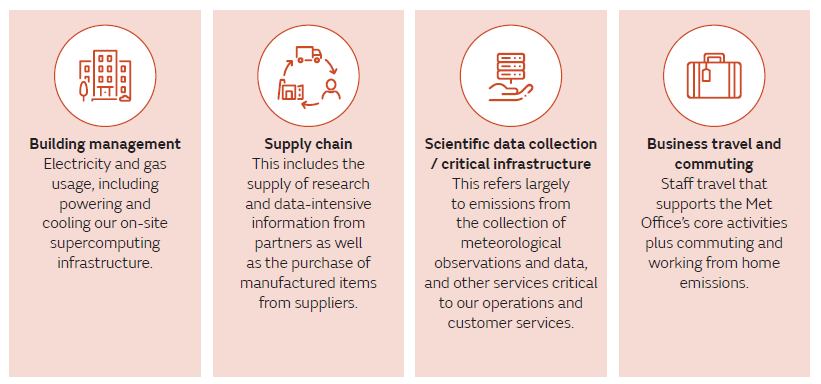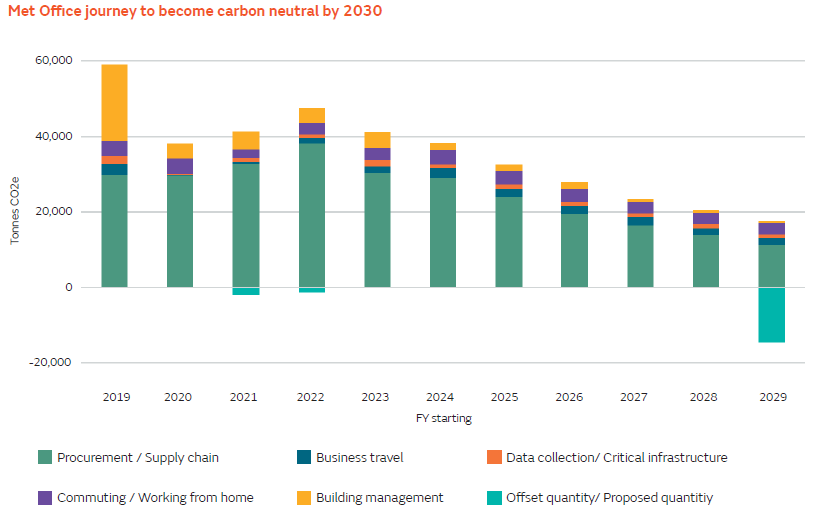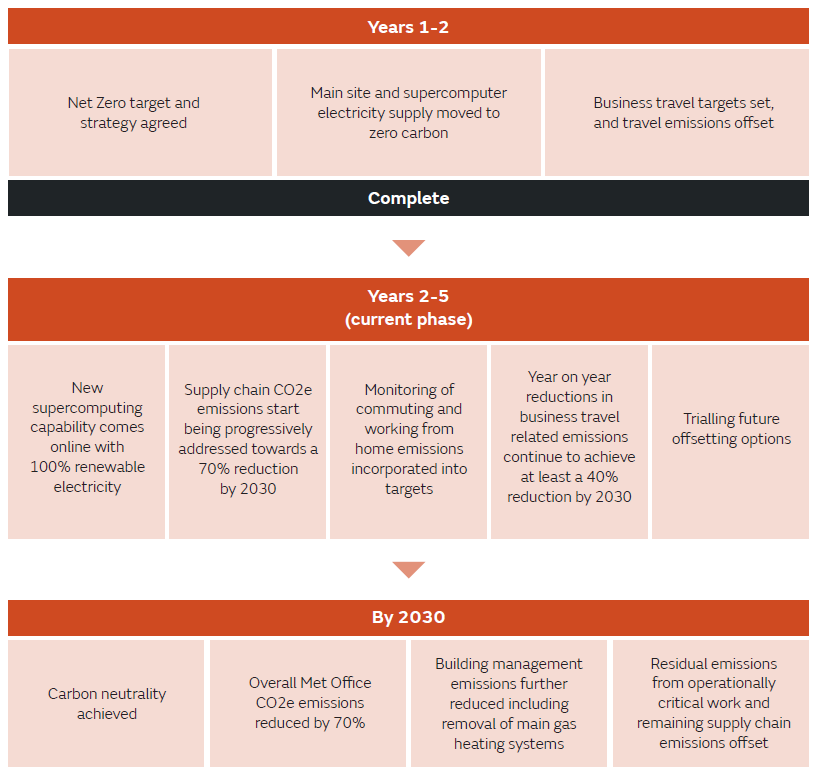Our journey to Net Zero; carbon neutral by 2030
How the Met Office is moving to carbon neutrality by 2030.
As a leading contributor to United Nations climate research the Met Office knows first-hand how greenhouse gas emissions are impacting our climate. We have therefore set out on our journey to Net Zero and charted a pathway to neutralise the harmful greenhouse gases from our operational activities and supply chain.
We aim to substantially reduce these, eliminating them where possible over the next decade, and offset residual emissions that are not currently possible to remove in their entirety.
Our emissions are measured in tonnes of carbon dioxide (CO2), the most common greenhouse gas, or an equivalent (CO2e) amount of other greenhouse gases such as methane, nitrous oxide or hydrofluorocarbons. Our total CO2e emissions are often referred to as our carbon footprint.
Contents
- Our starting point
- Existing successes
- Support for other organisations
- Next steps
- Met Office journey to Net Zero report
- Met Office travel
- Supercomputer and environmental benefits
Our starting point
To understand our carbon emissions an initial baseline assessment was conducted of the Met Office CO2e emissions for the 2019/20 financial year. We have since completed a thorough re-assessment of our baseline, incorporating all we have learned since we embarked on our journey. This includes a comprehensive view of the emissions from all the equipment and services we need to deliver our essential customer services. This allows us to identify key areas to tackle and those where we can make the biggest improvements.
Our baseline assessment divides emissions into four broad components:

Existing successes
We have already made significant achievements on our journey towards Net Zero.
- In 2020, the electricity supply to our main operational locations was switched to zero carbon electricity. As this included our current supercomputing capability located in Exeter, this has already saved over 15,000 tonnes CO2e emissions a year.
- We have taken a number of other measures to improve our building management efficiencies. This includes the installation of solar panels, the use of borehole water, recycling IT and improvements in waste management.
- We have set (and so far, exceeded) targets aiming to reduce business travel emissions by 40% by 2030. We have reduced our commuting emissions and will formulate plans to reduce them much further by 2030.
- We have previously used certified offsets for our remaining business travel emissions but are now investing in UK nature-based offsetting projects.
- We have engaged with our major suppliers, from those providing satellite data to those supporting our world-leading computing facilities, to understand their emissions and start working with them on their own net zero journeys.
- We have worked together with the international meteorological community to ensure all our future weather and climate services are provided in as sustainable way as possible.

Our updated pathway shown on the graph above outlines our ambition to reduce the Met Office’s baseline annual emissions, which were c. 59,000 tonnes of CO2e in FY2019/20. Achieving our projections would leave residual emissions of c. 17,600 tonnes CO2e by 2030, which could be reduced further or neutralised by offsetting.
Support for other organisations
Our substantial increase in supercomputing capability will lead to improvements in weather forecasts and climate change predictions. As the national deadline to reach Net Zero by 2050 looms, the new supercomputing capability will play a central role in understanding how carbon budgets and mitigation scenarios will avoid the most dangerous impacts of global climate change.
The Met Office is already working with leading businesses and organisations to increase energy efficiency and improve resilience with the long-term goal of reducing carbon emissions. Detailed forecasts are being used to optimise energy usage, improve efficiency of renewable energy sources and even reduce the carbon footprint of air travel, thanks to detailed wind forecasting helping to plan flight paths.
Next steps
To maintain our focus on becoming carbon neutral by 2030, we will work closely with our employees, partners, customers, supply chain and stakeholders in government and the wider meteorological community. Together we can make further real changes and adapt the way we work while still providing safety critical meteorological services and world-renowned climate science. Having prioritised organisational effort, from October 2019 to March 2023, to develop a science-based approach to reducing our CO2e emissions, we are now embedding our Net Zero approach into everything we do as a business.
We have already learned from those around us and the Met Office journey to carbon neutrality by 2030 will continue to be re-evaluated and adapted as more technologies become available. We will continue to develop detailed action plans to put in place for each step of our journey.

Met Office journey to carbon neutrality by 2030 report
Find full details of the Met Office Net Zero journey, as of March 2025.
Met Office travel
As an environmental organisation, we encourage our staff to consider greener alternatives to travel, both on the daily commute and while on business.
Travelling to work
Our head office in Exeter is in a prime location due mainly to its excellent transport links by road, rail and air, making it easily accessible from other parts of the UK and overseas.
Cycling to work
The Met Office supports Cycle 2 Work through which we provide help towards the purchase of bicycles and equipment for healthy, low carbon travel via a salary sacrifice scheme.
We also have a Met Office Bicycle Users Group (MOBUG) group which organises social trips at weekends and night rides during summer months; the group promotes the health benefits and social aspects of cycling.
We also have a selection of pool bikes at our headquarters that staff can borrow including two electric bikes and a fold up bike. Using the pool bikes often help staff decide the type of bike they would like if they are thinking of purchasing their own.
Travelling for work
We work with Clarity Travel Management to help with our business travel needs. By using a single service provider, we are able to reduce costs and increase efficiency.
Air travel
However, as an organisation with the environment very much at its heart, we recognise the need to limit air travel. Therefore, our staff must go through a rigorous justification process in order to determine whether air travel is essential. Our Travel Policy requires lower carbon options to be considered first as an alternative to each planned business flight – this is a requirement under the Greening Government Commitments.
In order to reduce the need for air travel, alternative approaches such as Microsoft Teams and video conferencing are available. We are always keen to work with our external partners to facilitate effective remote participation to avoid air travel if possible.
The white fleet (our owned and leased vehicles)
We have leased two fully electric pool cars at our Exeter headquarters for business travel and we are working to move our operational vehicle fleet over to zero emissions vehicles in line with the Greening Government Commitments.
Supercomputer and environmental benefits
Our supercomputer, or High-Performance Computer (HPC), takes in hundreds of thousands of weather observations from all over the world. It uses these observations as a starting point for running an atmospheric model containing more than a million lines of code. As of 2020, our supercomputer has been powered by zero carbon electricity.
The capacity of our supercomputer enables us to improve our weather and climate forecasts. These forecasts help people make better-informed decisions, realising socio-economic benefits by avoiding costs, reducing waste and improving efficiency and effectiveness.
Ultimately, our supercomputer helps to shape a more sustainable world - from warning of extreme weather to helping communities plan for and reduce the impacts of climate change.
Delivering environmental benefits
The supercomputer requires a large amount of energy to run and maintain - about 2.7 MW of electricity. Everything possible is done to minimise this, and the power consumption remains small in comparison to the socio-economic benefits that the supercomputer makes possible.
Take our global aviation forecasts, for example, which enable airlines to save fuel by using the wind to help carry them to their destination, helping to reduce carbon dioxide emissions through increased efficiency.
Crucially, Met Office forecasts save lives through our Severe Weather Warnings, mountain area forecasts, marine forecasts, and a host of other services, including our climate advice and services which help avoid widespread and dangerous impacts of climate change.
Supercomputing makes it possible to increase high-resolution climate modelling and provide more complete Earth System models to better assess future impacts of a changing climate at a regional scale, especially from high impact weather. This gives decision-makers a clearer picture of climate change and what it will mean, helping to plan for a more sustainable future.
Find out more about our supercomputer.
Reporting our energy consumption
Our greenhouse gas emissions performance is overseen by our Responsible Business Committee which includes an Executive Board member. Each year we publish details of our energy performance in the Sustainability section of our of our Annual Report which also includes our Task Force on Climate-related Financial Disclosures Report.
Last updated: March 2025


